Read on below to learn more about the new Stellar Crown expansion as part of Pokémon TCG: Scarlet & Violet.
Pokémon TCG expert Tord Reklev explores how to best realize the Tera Pokémon’s true potential.
By Tord Reklev, Contributing Writer
The new Pokémon Trading Card Game expansion, Scarlet & Violet—Stellar Crown, has just been released, and with it are a bunch of powerful Pokémon and Trainer cards. The most anticipated Pokémon from the set so far is Terapagos ex, a new Colorless-type Legendary Pokémon ex. There are a lot of different ways to play Terapagos ex, and today I will introduce you to my current favorite way to utilize the new cards!
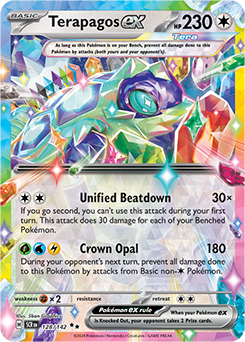
Terapagos ex
Pokémon (24)
- 3Terapagos ex 170/175
- 3Noctowl 115/175
- 3Hoothoot 114/175
- 2Pidgeot ex 164/227
- 2Pidgey 162/227
- 2Dusknoir 70/64
- 1Dusclops 69/64
- 2Duskull 68/64
- 2Bouffalant 119/175
- 1Bloodmoon Ursaluna ex 222/167
- 1Fezandipiti ex 92/64
- 1Squawkabilly ex 169/193
- 1Fan Rotom 118/175
Energy Cards (4)
- 4Double Turbo Energy
Trainer Cards (32)
- 2Iono
- 2Professor’s Research (Professor Oak)
- 1Boss’s Orders (Giovanni)
- 1Briar
- 1Professor Turo’s Scenario
- 4Area Zero Underdepths
- 4Nest Ball
- 4Rare Candy
- 3Night Stretcher
- 3Ultra Ball
- 2Buddy-Buddy Poffin
- 1Counter Catcher
- 1Feather Ball
- 1Hisuian Heavy Ball
- 1Pal Pad
- 1Prime Catcher
The idea behind this list is to take maximum advantage of Terapagos ex’s Unified Beatdown. Normally, this attack wouldn’t look too impressive, but it can do a lot more damage with the Stadium card Area Zero Underdepths. With eight Benched Pokémon, Unified Beatdown can do 240 damage, which is enough to Knock Out the most popular two-Prize Pokémon ex. Seeing as this attack only needs ![]()
![]() , it can easily be charged by attaching a single Double Turbo Energy. This will weaken its attack by 20 damage, but 220 is luckily still enough to reach a lot of important Knock Outs.
, it can easily be charged by attaching a single Double Turbo Energy. This will weaken its attack by 20 damage, but 220 is luckily still enough to reach a lot of important Knock Outs.
Terapagos ex’s Crown Opal attack is also interesting, but since its Energy cost requires so much more effort, I have chosen to forego this attack completely to focus on Unified Beatdown.
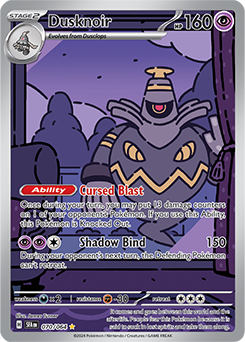
There are still many evolved Pokémon with high HP that could give Terapagos ex problems and punish it for not knocking them out immediately, for example by using cards like Professor Turo’s Scenario or even Collapsed Stadium to remove the damaged Pokémon. To avoid this problem, this deck includes a line of Dusknoir with the Cursed Blast Ability, an excellent way to finish off big threats.
Dusknoir also has great synergy with the new Supporter card Briar. This card is a perfect fit for this deck, as it can allow Terapagos ex to take an additional Prize card whenever the opponent has two Prize cards remaining. With Dusknoir, or even Dusclops, a Prize card can be forced upon the opponent to then activate Briar and potentially end the game. Important to note: If the opponent already has two Prize cards remaining, but there is still a need to use the Cursed Blast Ability, Briar can be played first, and then the Ability can be used after. Briar’s effect will still be active when attacking, even if the opponent no longer has two Prize cards remaining.
Now that we know what we want to accomplish, it’s time to talk about how to get there and which support Pokémon make up the deck’s engine.
Scarlet & Violet—Stellar Crown has plenty of great cards to partner with Terapagos ex, and Noctowl is no exception. Noctowl’s Jewel Seeker Ability lets the player access any two Trainer cards from the deck and add them to their hand, with the only requirement being having a Tera Pokémon in play, which in this case will be Terapagos ex. This is similar to Inteleon’s Shady Dealings Ability, which used to be one of the best Abilities in the format.
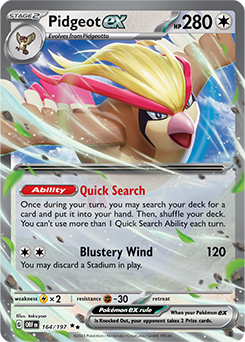
One of the strongest plays this enables in the early game is the search of a Feather Ball and a Rare Candy to effortlessly establish an early Pidgeot ex. Quick Search is by far my favorite Ability of all time, and it is excellent in this deck as well, most notably being able to search for Double Turbo Energy, which can be difficult to access otherwise. Pidgeot ex’s Blustery Wind attack can also be used in a pinch.
This already sounds great, but it doesn’t stop there. Fan Rotom’s Fan Call Ability can search out just about everything needed for the first turn, including Hoothoot, Noctowl, Pidgey, and even Bouffalant.
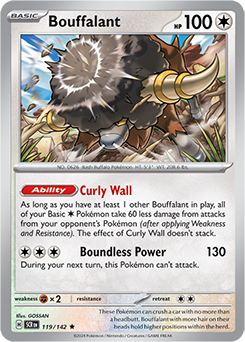
Bouffalant’s Curly Wall Ability not only helps protect low-HP Pokémon like Pidgey and Hoothoot until they can evolve, but it also makes Terapagos ex very difficult to Knock Out as well. With the Curly Wall Ability, Terapagos ex now effectively has 290 HP as a Basic Pokémon. Combine that with the power to swing for 220 damage with only a single Energy attachment, and you have an extremely cost-effective Pokémon.
Squawkabilly ex is another Pokémon that can take advantage of the Curly Wall Ability to tank bigger hits, but it’s mainly included to be a good backup plan with its Squawk and Seize Ability, should the opening hand not be the greatest for setup.
The final support Pokémon is Fezandipiti ex. Flip the Script is one of the best ways to refill the hand after a Knock Out. This card is simply too strong to not be included and has become a staple for almost all the most successful decks in the format.
Having only four Energy cards total might seem unreasonably low, but keep in mind that there have been multiple top-tier decks in the past with similar Energy card counts. The most recent example is Mew VMAX, and going further back, there were decks like Night March and Seismitoad-EX.
The total amount of draw Supporters is also low; this is because the deck is trying to end the game very quickly. Using Dusknoir’s Cursed Blast Ability and Briar will significantly reduce the amount of turns a normal game will take, and there won’t be many turns to play Supporter cards at all. With Jewel Seeker and Quick Search, the deck should be able to access key Supporter cards when needed, without having to play a greater number to find them naturally. Pal Pad can be used in the cases where a game lasts longer than normal or if important Supporter cards got discarded earlier.
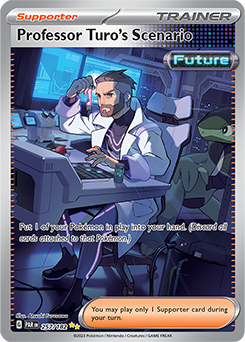
Professor Turo’s Scenario is chosen as a mobility card, which is important when we play so few Energy cards total; ideally, those Energy cards should not be spent by manually retreating. It can also function to deny Prize cards by removing a damaged or weakened two- Prize Pokémon, like Terapagos ex or Squawkabilly ex. The reason Professor Turo’s Scenario is chosen over Penny is because it can also pick up Noctowl, which is crucial against control and stall matchups, and can reset Jewel Seeker for the following turn.
Prime Catcher is another mobility card and strengthens the strategy of targeting a Pokémon ex or Pokémon V before it can evolve. Pidgeot ex can be promoted thanks to its free Retreat Cost should there be a need to play Prime Catcher with Terapagos ex already in the Active Spot.
Night Stretcher being played so heavily is to reestablish the board after Area Zero Underdepths gets removed by the opponent and to make sure it’s easy to use Cursed Blast repeatedly.
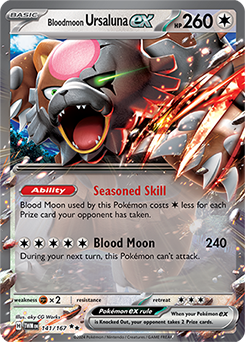
Bloodmoon Ursaluna ex cannot take advantage of Briar, but when the opponent has just one Prize card remaining, it can attack for slightly more damage than Terapagos ex. This can make a huge difference if the deck is playing against something like Roaring Moon ex or Raging Bolt ex. With this inclusion, you can feel even more confident in this deck’s low Energy count. Bloodmoon Ursaluna ex is also notably a Colorless-type Pokémon and can effectively be boosted to 320 HP by Bouffalant’s Curly Wall Ability.
Since Unified Beatdown cannot be used going second, the deck is far better off going first whenever possible. This allows the support Pokémon to come down onto the Bench before they are threatened to get Knocked Out, while Terapagos ex and Cursed Blast can apply pressure before the opponent has a chance to evolve their own Pokémon.
As with any deck that plays Pidgeot ex, it is highly recommended to prioritize setting up Pidgeot ex early, as it gives near perfect control over the resources available. Remember to take advantage of Fan Rotom, Noctowl, and Feather Ball for the easiest setup.
This deck excels at manipulating the Prize trade. Should you be forced to go second, try to avoid putting a two-Prize Pokémon on the Bench. Since the deck cannot attack yet regardless, the focus should be on denying Prize cards from the opponent. Treat the opponent’s Prize cards as a resource, as they will dictate how many Cursed Blast Abilities can be used.
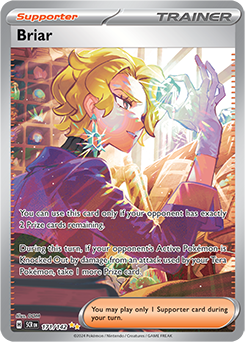
Ideally, try to find a way to close out the game in two or three attacks, with the help of Briar and Cursed Blast. A common situation is to have four Prize cards left while the opponent is at either two or three Prize cards. By using Cursed Blast to take a single-Prize Knock Out, Briar can then be used to take three Prize cards with Unified Beatdown.
Sometimes the Prize trade can still be difficult to win, even with all the tricks available. If that is the case, look for a way to remove all the opposing attackers simultaneously with one or more uses of Cursed Blast, and combine it with Iono to leave the opponent with limited options to respond. Make sure to use Cursed Blast before Iono to leave the opponent with even less cards available.
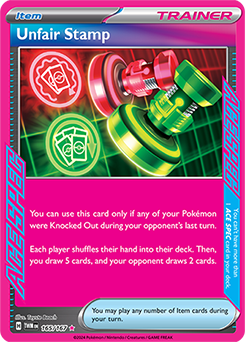
As an alternative ACE SPEC card, Unfair Stamp can be used to provide additional disruption and card draw. If included, it is recommended to add another Counter Catcher to make up for the loss of access to the opponent’s Benched Pokémon. The loss of mobility might also need replacement.
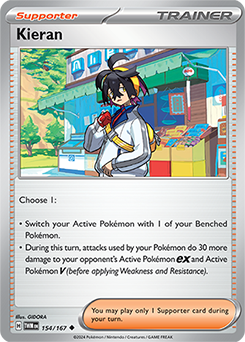
Kieran can provide mobility and additional damage output. This allows Terapagos ex to hit the same numbers as Bloodmoon Ursaluna ex—potentially more when combined with Defiance Band. These two cards together can put even Pokémon VSTAR in range of a clean Knock Out.
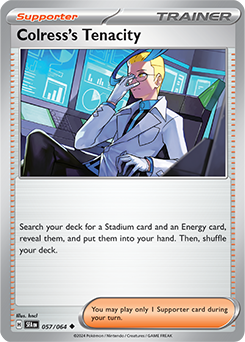
Most of the time, the cards the deck is looking for are Area Zero Underdepths and Double Turbo Energy. Colress’s Tenacity can get both of them and functions as a bridge between Jewel Seeker and Double Turbo Energy, which normally can only be accessed by Quick Search. Be aware that Kyurem from Scarlet & Violet—Shrouded Fable can punish the use of this Supporter by enabling its Trifrost attack for only ![]() .
.
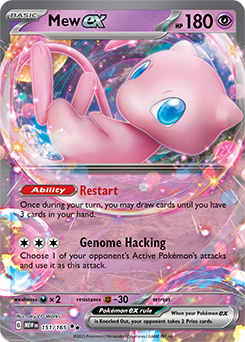
If you want to go for an even more aggressive variant without Pidgeot ex, Mew ex can fulfill the role of a free retreat Pokémon, while also giving some protection against hand disruption. Of course, Restart is not as powerful of an Ability as Quick Search, but being a Basic Pokémon makes Mew ex a lot easier to set up than Pidgeot ex.
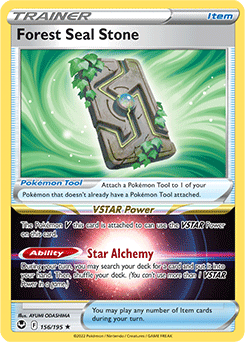
Rotom V can provide additional draw with its Instant Charge Ability during the first turn going first or second, as the deck doesn’t have an option to attack then regardless. For the most part, Rotom V will just be used as a target for Forest Seal Stone. Rotom V goes well together with Mew ex in the more aggressive variant of the deck.
In a way, this deck’s engine feels like it is playing in the Expanded format. The speed, consistency, and power level are all high, and Dusknoir with Briar can end the game as early as Turn 3! I would classify the deck as a “glass cannon” deck, meaning it can go one of two ways—total domination or a total miss. Decks with Dusknoir tend to be good at maintaining their lead, but they’re weaker when needing to catch up from a slower start.
Regardless, the games are fast paced and action packed, and it is some of the most fun I have had playing Pokémon in a long time. Try it out for yourself, and see how many Prize cards you can take in a single turn.
The deck is a blast—literally!
Tord Reklev

Tord Reklev is a contributing writer for Pokemon.com. He is a longtime player from Norway, playing the game since he was 6 years old. In becoming Champion at the 2022 Latin America International Championships, Tord is the first player to win all four International Championships and complete the Grand Slam. Outside of the game, he is a student and enjoys playing tennis. You can find him at most big events and can follow him on X at @TordReklev.
Source: Pokemon.com
Source: Pokemon

